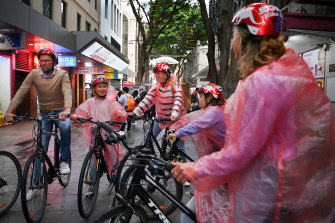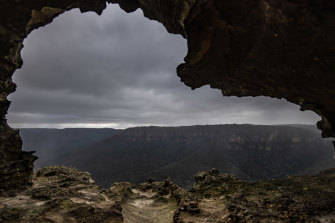The wet weather is expected to linger over much of the east coast until November, with saturated soils and bursting water systems likely to increase the risk of flooding in NSW.
The state has already experienced three major flooding events this year, with many communities just starting the mammoth clean-up effort from the most recent rain in July.
Riders in the storm: Maarten Werksma with his wife Berthilde, and their daughters Fiene, Suze and Eva in Chinatown on Thursday.Credit:Kate Geraghty
The Bureau of Meteorology’s outlook for August to October has forecast above-average rainfall from eastern Queensland to the South Coast of NSW, with parts of Victoria and the Northern Territory likely to also experience heavy rainfall.
The agency also warned that saturated soil from recent rainfall events, as well as full water systems – including most dams around NSW above 70 per cent capacity, would exacerbate flooding risks across much of eastern Queensland and NSW for the coming months.
Sydney has already recorded its wettest July on record, with 365 millimetres falling in the CBD. The previous wettest July was 1950 with 336 millimetres. The usual average rainfall in July for Sydney is 96mm.
Weatherzone meteorologist Joel Pippard said it was also likely the city could record its wettest year, breaking the previous record of 2194 millimetres. To date, the city has recorded 1913 millimetres.
Large parts of the state can expect the wet weather to continue over the coming months.Credit:Wolter Peeters
“On average for August to December, we record 386mm. So if we get average rainfall we will break that record,” Pippard said.
Hazardous surf and wind warnings are in place across NSW and Queensland ahead of a low-pressure system predicted to bring another bout of heavy rain on Friday.
An upper-level trough passed through the east coast on Thursday, causing rain to lash both states.
A low-pressure system developing over the Coral Sea is expected to bring increased showers for the NSW coastline, according to Weatherzone. On Friday, the weather service said the upper-level trough will move further east and cause the Coral Sea low to deepen off south-east Queensland.
Festival goers attending Splendour in the Grass in Byron Bay on the North Coast are advised to pack gumboots. Weatherzone forecasts up to 10 millimetres on Friday, following the 20 millimetres the region received on Thursday. Temperatures will stay below 20 degrees in Byron for the duration of the festival, topping out over the weekend at 18 degrees, according to predictions.
In Victoria, the weather is likely to remain dry until the weekend when a trough brings some rain over the state. Monday is likely to bring 5 to 10 millimetres of rain in Melbourne, with another 3 to 8 millimetres on Tuesday.
A negative Indian Ocean Dipole is likely to occur in the next two weeks which would see above-average rainfall occur for much of Australia. Pippard said the warm waters off the northern shelf of Australia would bring more moisture and cold fronts across the majority of the country, bringing more rainfall.
Meanwhile, the Bureau of Meteorology remains on high alert for another La Nina to emerage, with a 50 per cent chance of a third one occurring this year.
It’s uncommon to have a three-year La Nina event, which has occurred only three times since the middle of the last century. Australia has experienced 19 La Nina events since 1900 and 13 have coincided with flooding in eastern states. The average rainfall from December to March in La Nina years is 20 per cent higher than the long-term average.
Get to the heart of what’s happening with climate change and the environment. Our fortnightly Environment newsletter brings you the news, the issues and the solutions. Sign up here.
Most Viewed in Environment
From our partners
Source: Read Full Article

